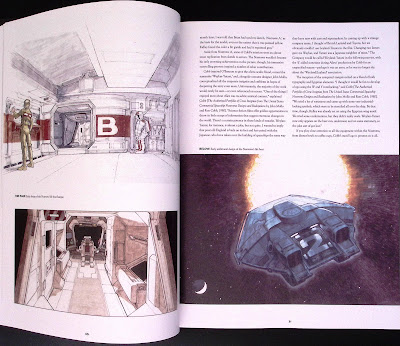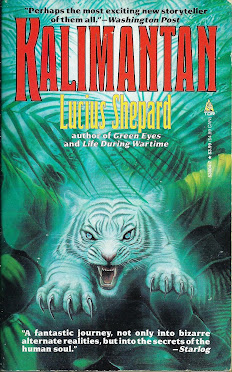October 2023 is Spooky StORIES MOnth
at the PORPOR BOOKS BLOG !
at the PORPOR BOOKS BLOG !
My Top 22 Horror Short Stories
October 2023
October 2023
I've been reading horror stories since 1970, when I was 9 years old and I saw a copy of Alfred Hitchcock's Monster Museum (Random House, 1965) on the shelf of my grammar school library.
While most of the stories in the book were rather tame - it was aimed at an audience of juvenile Baby Boomers, after all - Joseph Payne Brennan's story 'Slime' immediately gripped my attention, and from then on, my interest in the genre began, and has lasted since.
After some contemplation, I've decided to stand forth with a list of 22 short stories that in my humble opinion are the better ones I've encountered in 50 years of reading all manner of horror fiction. Since it's the interval covered by this blog, I've concentrated on stories that first saw print from the 1960s into the mid-1990s.
I've posted a brief, one-sentence synopsis for each story, to jog memories or to give the reader a sense of what to expect.
One problem with focusing on such stories is that in many instances the books where they first appeared long are out of print, and copies in good condition have steep asking prices. Accordingly, where available, I've tried to provide alternate sources for obtaining these stories.
My Top 22, in chronological order:
The First Days of May, by Claude Veillot, The Magazine of Fantasy and Science Fiction, December 1961; Tales of Terror from Outer Space, 1975
‘Alien invasion’ theme, well done.
***
One of the Dead, by William Wood, The Saturday Evening Post, October 31, 1964; Alfred Hitchcock Presents: Scream Along with Me; A Walk with the Beast, 1969; Great American Ghost Stories, 1991
Although a bit over-written, this is a well-crafted melding of the haunted house theme with the anomie of mid-1960s life in suburban Los Angeles.
***
The Road to Mictlantecutli, by Adobe James, Adam Bedside Reader, 1965; The Sixth Pan Book of Horror Stories,1965; The Arbor House Treasury of Horror and the Supernatural, 1981
Morgan, a ruthless criminal, is travelling on a mysterious road in Mexico. The strange sights and passions he encounters will lead him to change his life........for good, or for ill.
'Adobe James' was the pseudonym of American writer James Moss Cardwell (1926 – 1990), who had his short stories published in a variety of magazines and anthologies during the 1960s, 1970s, and 1980s.
***
Longtooth, by Edgar Pangborn, The Magazine of Fantasy and Science Fiction, January 1970; The Best of Modern Horror, 1989
A resident of rural Maine discovers something disturbing in the deep, dark woods.
***
Goat, by David Campton, New Writings in Horror and the Supernatural #1, 1971; Whispers: An Anthology of Fantasy and Horror, 1977
Creepy goings-on in an English village.
***
Satanesque, by Alan Weiss, The Literary Magazine of Fantasy and Terror, #6, 1974; The Year’s Best Horror Stories: Series III, 1975
Starts off on a thoroughly conventional note, then unexpectedly transitions into something entirely imaginative and offbeat.
***
The Shortest Way, by David Drake, Whispers #3, March 1974; From the Heart of Darkness, 1983; Vettius and His Friends, 1989; Night & Demons, 2012
A 'Vettius' story set in the days of the Roman empire. Our hero elects to travel on a road that the locals take care to avoid. An atmospheric, memorable tale.
***
The Taste of Your Love, by Eddy C. Bertin, The Year’s Best Horror Stories: Series III, 1975; The Whispering Horror, 2013
One of the better Serial Killer tales I’ve read.
***
The Changer of Names, by Ramsey Campbell, Swords Against Darkness II, 1977; The Year’s Best Fantasy Stories: 4, 1978; Far Away and Never, 2021.
I've never been a fan of Campbell’s horror stories and novels, but his sword-and-sorcery stories featuring the ‘Ryre’ character are entertaining exercises in creepiness. There are metaphors and similes abounding in the Ryre tales, to be sure, but as compared to Campbell's horror stories the purple prose is reduced in scope, and plotting receives due consideration.
While the Swords Against Darkness paperbacks have exorbitant asking prices, a new (October 2021) reprint of Far Away and Never from DMR Press collects all four of the Ryre stories, along with other fantasy tales from Campbell's early career.
***
Long Hollow Swamp, by Joseph Payne Brennan, Alfred Hitchcock’s Mystery Magazine, January 1976; The Year’s Best Horror Stories: Series V, 1977
Another great 'monsters-on-the-loose' tale from Brennan.
***
Sing A last Song of Valdese, by Karl Edward Wagner, Chacal #1, Winter 1976; The Year’s Best Horror Stories: Series V, 1977; Night Winds, 1978, 1983
One of two entries by Wagner, who wrote a lot of duds, but when he was On, he was On. In a remote forest, a lone traveler comes upon an inn filled with sinister characters.
***
Window, by Bob Leman, The Magazine of Fantasy and Science Fiction, May 1980; The 1981 Annual World’s Best SF, 1981; The Best of Modern Horror, 1989
A neat mix of sci-fi and horror, revolving around a portal to another dimension.
***
Where the Summer Ends, by Karl Edward Wagner, Dark Forces, August 1980; In A Lonely Place, 1983; The American Fantasy Tradition, 2002
A second entry from Wagner. It’s hot, humid, and dangerous in 1970s Knoxville. Stay away from the kudzu !
***
The New Rays, by M. John Harrison, Interzone #1, Spring 1982, The Year’s Best Horror Stories: Series XI, 1983; The Weird: A Compendium of Strange and Dark Stories, 2012
A disturbing tale with proto-steampunk leanings.
***
After-Images, by Malcolm John Edwards, Interzone #4, Spring 1983, The Year’s Best Horror Stories: Series XII, 1984; Interzone: The First Anthology, 1986
Another fine melding of sci-fi and horror, this time set in an English suburb. It’s too bad that Edwards, a playwright and editor, didn’t write more short stories.
***
The Man with Legs, by Al Sarrantonio, Shadows No. 6, October 1983, The Year’s Best Horror Stories: Series XII, 1984
Two kids learn some disturbing secrets about their family history.
***
High Tide, by Leanne Frahm, Fears, 1983
Frahm, an Australian writer, sets this novelette in the vicinity of the Newry Islands in coastal Queensland. A family camping trip to Mud Island discovers something strange is going on amidst the mangrove swamps: Eco-horror at its creepiest !
***
Mengele, by Lucius Shepard, Universe 15, 1985, The Jaguar Hunter, 1988
Troubling things are going on at an estate located in a remote region of Paraguay.
***
Red Christmas, by David Garnett, The Year's Best Horror Stories: Series XIV, 1986
What seems like a conventional Mad Slasher story has a neat little twist at the end.
***
Unsettling events are happening in the graveyard of a Welsh coal-mining village.
***
The Bacchae, by Elizabeth Hand, The Year's Best Horror Stories: XX, 1992.
In a decaying near-future America, women have gained mysterious, and deadly, powers. This story has the amorphous quality of Weird Fiction, but laces it with splatterpunk imagery.
***
Shining On, by Billie Sue Mosiman, Future Net, 1996
A mutant suffering from severe handicaps finds a friend online. But you know what they say about online friends: just who are they in person ?















































































